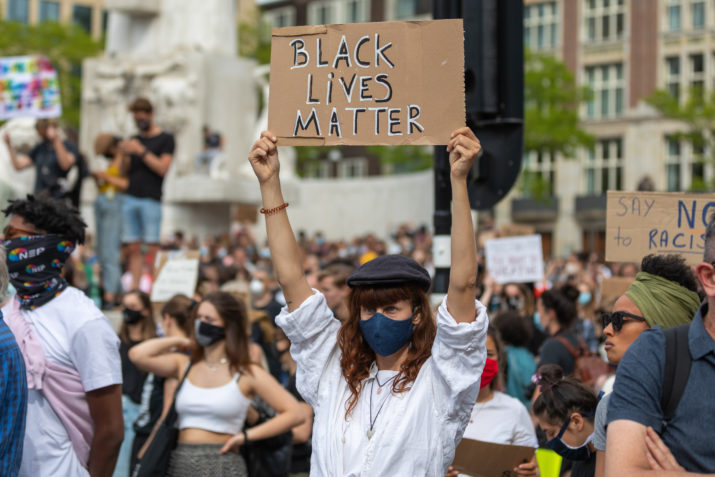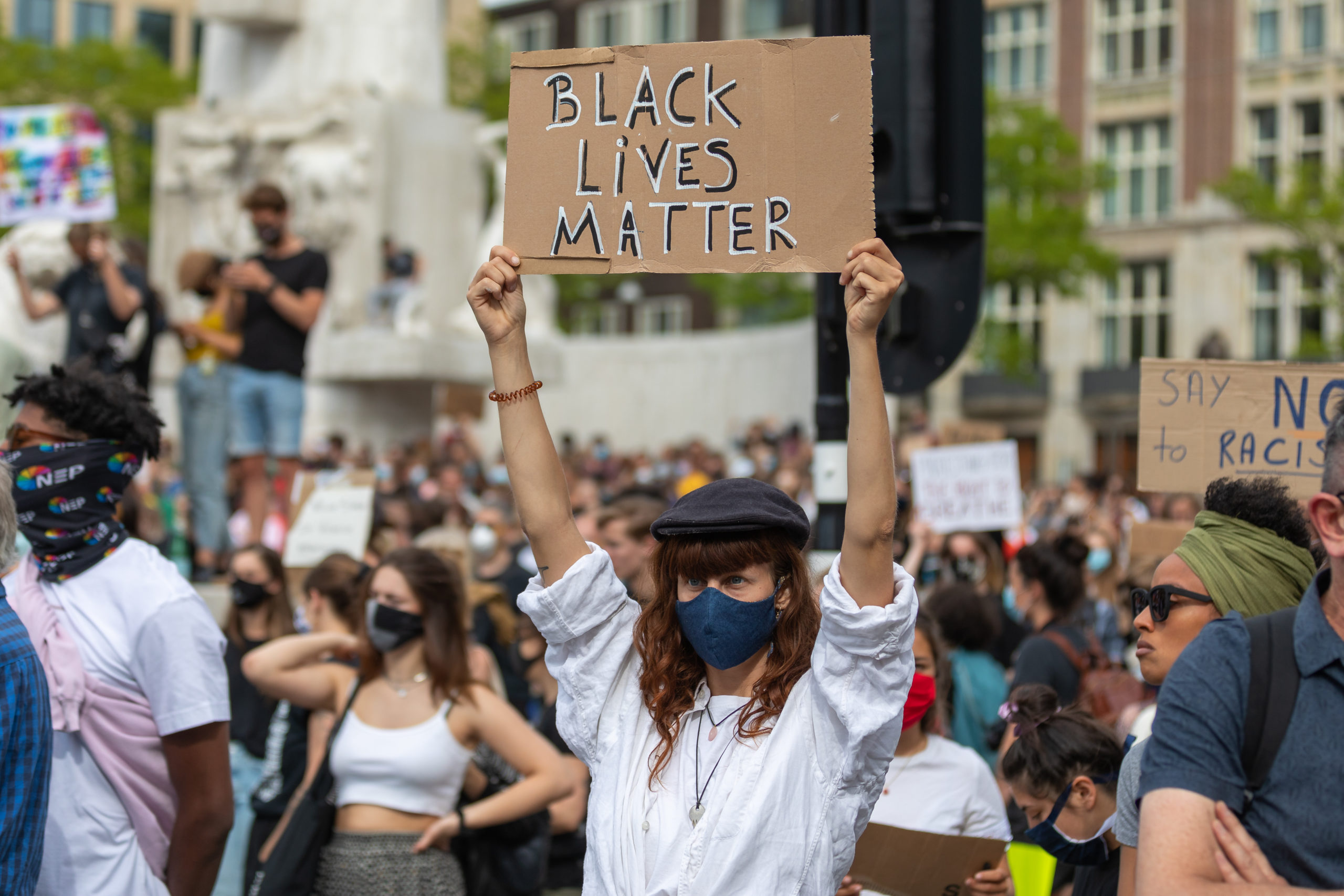

This is part of our special feature on Race and Racism in Europe: The Urgency of Now.
In the midst of the COVID-19 pandemic, the murder of George Floyd in Minneapolis sparked anti-racist protests across the world. Demonstrations in France connected Floyd’s death with their own state violence against post-colonial citizens, Portuguese protestors carried placards stating “Racism is colonial heritage,” and in Belgium, protestors tore down the statue of King Leopold II. Of course, statues were not only targeted in Belgium, but were a target throughout the world, with statues of Cecil Rhodes, for instance, being taken down in both Cape Town and Oxford.
Within Britain, debates over such statues of colonial figures took center-stage during the anti-racist protests. To some, the fact that figures such as Edward Colston—a key figure in Britain’s role in enslavement—were not just put up on a literal pedestal, but that their statue plaques also described them (in Colston’s case) as “one of the most virtuous and wise sons of the city,” was evidence to such protestors that Britain had yet to confront its colonial past. Indeed, to such protestors, this was an issue of the present, not just an issue of the past; by failing to bring a critical eye to historical figures, Britain was making a statement in the present day as to which histories and people they value. By contrast, those who were critical of the protests saw such statued figures as being products of their own time, capable of being praised for their contributions to Britain without having to be moralized as evil.
This essay is not about statues inasmuch as it is about the contemporary denial of racism in Britain. However, my argument is that it is the same logic that inspires so many people to view the British empire as being a philanthropic endeavor—as seen in their vehement defence of colonial statues—that also drives the view that Britain is not “racist” in the present day. In other words, there is an inherent connection between Britain’s “postcolonial melancholia” (Gilroy 2004), and the country’s commitment to post-racialism. I will demonstrate this argument by focusing on how representations of a benign, charitable British empire relate to the state’s exonerating themselves from any responsibility for the disproportionately high COVID-19 mortality rate for Black, Asian, and minority ethnic (BAME) Brits in the present day.
The postcolonial roots of Britain’s post-racialism
In his work The Empire Strikes Back, Stuart Hall (2017: 200) states:
Empires come and go. But the imagery of the British Empire seems destined to go on forever. The imperial flag has been hauled down in a hundred different corners of the globe. But it is still flying in the collective unconscious.
In this comment, Hall brings attention to the power that the British empire still has over the British psyche. This affectual power of the British empire can be captured in what scholars refer to as the paradoxical “little Englander” spirit. This “little Englander” spirit is paradoxical because, on the one hand, it is based around the premise that Britain ought to withdraw itself from international affairs, but on the other hand, it is crystallized around the belief in British self-determination and Britain being a global superpower despite its underdog status. The fact that Britain colonized one quarter of the world is seen as emblematic of this little Englander spirit, as Britain is construed as a miniscule island that managed to create a global empire. The empire, therefore, is a source of national pride as it supposedly signals Britain’s unrivalled work ethic, philanthropy, and civilizational values. This positive self-representation of the British empire is typified in a recent YouGov (Smith 2020) poll, which found that Britain, more than other European countries, believes that formerly colonized countries are “better off” due to colonialism.
When Hall thus comments that “the imagery of the British Empire seems destined to go on forever,” he is critiquing a specific, skewed representation that Britain has produced of its colonial apparatus. Through this “imagery,” Britain is seen as the benevolent fighting-force for good who freed the enslaved (but never played a role in enslavement), ridded the globe of fascism (because the empire did not deny human rights to their colonized subjects), granted independence to the colonies while incorporating them into a prosperous Commonwealth (while never infringing upon their independence in the first place), and welcomed postcolonial citizens into their “mother country” with open arms (without subjecting these very same people to economic, social, and political marginality).
The little Englander imagery of British history, therefore, is an imagery that bifurcates the country from its unequal colonial relations. Thus, British history textbooks focus on the nation’s industrial revolution and modernization as the outcome of British ingenuity, rather than recognizing the sheer amount of capital that was funnelled from colonial territories to fund this modernization; Utsa Patnaik (2017), for instance, shows how over nine billion pound’s worth of capital was channelled from India into the British economy between 1765 and 1938. These same textbooks envisage Britain as a fighting force against fascism through defeating the Nazi’s in World War II, or the most democratic nation since they constructed a welfare state, without acknowledging how the Nazis actually drew upon Britain’s colonial tactics when designing the Holocaust (Goldberg 2015), and how the creation of the welfare state itself relied on colonial taxation in places like India (Bhambra and Holmwood 2018), as well as extracting resources of profitable materials such as rubber and tin from countries like Malaysia (Newsinger 2018). The “imagery of the British Empire,” which “is still flying in the collective unconscious,” therefore, is an imagery itself built around ideas of British benevolence, charitability, esteemed civilizational values, and consequently, British innocence.
This essay is not concerned with blame. However, we have to recognize that this deep-seated dismissal of culpability from previous injustices in the name of empire, which is so essential to Britain’s view of its past, actually prevents Britain from knowing in different ways. By this, I mean that Britain’s commitment to its specific view of itself prevents other histories from being known and given legitimacy—including those histories that see Britain not through the lens of abolition, democracy, and multiculturalism, but through the connected histories of enslavement, colonial dispossession, and postcolonial exclusion. Moreover, through upholding this notion of British innocence, and consequently devaluing alternate knowledges and histories of Britain, the state is able to maintain its vision of inculpability when it comes to the present inequalities faced by the nation’s racialized minorities. In other words, Britain’s claim to historical innocence connects with the British state’s insistence on not being responsible for contemporary racialized injustices.
In Britain, the ideology of post-racialism—the idea that racial minorities do not face structural barriers that impede their progress—has post-colonial roots. The same logic that reframes British colonialism as a democratizing “civilizing” mission, and that reframes the economic exploitation of postcolonial citizens as charitable “Commonwealth migration,” is the same logic we see right now, where the state is reframing the disproportionate COVID-19 mortality rate of BAME people as being the result of “not racism.” It is this reframing of COVID-19 BAME deaths as “not racism,” and the state’s pleaded innocence, that I now want to focus on.
Post-racializing BAME deaths
“Being Black, or from a minority ethnic background, is a major risk factor.” —Matthew Hancock, Secretary of State for Health and Social Care
In Britain, BAME people are disproportionately represented in poor housing, insecure employment, unemployment, underemployment, and poverty (Brynin and Longhi 2015). Given the long-known fact that social deprivation has negative health consequences, it is no wonder that racism—in terms of the unequal distribution of societal resources across racial lines—has been a “fundamental cause” in COVID-19 morbidity. Nevertheless, despite the disproportionate COVID-19 death-rate facing people of color in Britain, this inequality is not seen as being emblematic of structural racism, and people of color have ended up being blamed themselves for their higher death rate. This blaming of BAME people for their higher death rate from COVID-19 is largely justified through the lens of cultural pathologization.
Of course, blaming the already stigmatized during a pandemic is not a new phenomenon. Throughout history, for instance, we repeatedly see that health crises often get construed as “moral crises.” Briggs (2005: 273) highlights this dynamic when he comments on how racial hierarchies lead to a construction of epidemics:
[…] in such a way that getting cholera or living in an infected neighborhood constitutes natural proof of a moral failure to conduct oneself in a rational, informed manner.
It is through this framing of health crises as “moral crises” that post-racialism justifies the BAME COVID-19 death rate as being a result of this group’s own moral deficiencies. As the Conservative MP Craig Whittaker so clearly articulated himself (BBC 2020):
If you look at the areas where we’ve seen rises and cases, the vast majority—but not by any stretch of the imagination all areas—it is the BAME communities that are not taking this seriously enough.
This post-racial cultural pathologization, moreover, is not simply a “right-wing” ideology pursued by conservative MPs such as Craig Whittaker. Consider, for instance, the non-partisan Public Health England (PHE 2020) report that set out to directly investigate why the COVID-19 death rate was higher for BAME people. Within this PHE report, we see that the structural conditions of BAME people are regularly ignored, at expense of their supposed cultural values and practices. Thus, rather than focusing on how BAME people are disproportionately exposed to air pollution which weakens lung capacity and increases likelihood of asthma, or their aforementioned poor economic and housing situations, the PHE (2020: 7-8) report instead goes down a route of “coronaphobia” in focusing on how BAME people are afraid of being tested:
Fear of diagnosis and death from COVID-19 was identified as negatively impacting how BAME groups took up opportunities to get tested and their likelihood of presenting early for treatment and care. For many BAME groups lack of trust of NHS services and health care treatment resulted in their reluctance to seek care on a timely basis, and late presentation with disease.
Through this reading of BAME groups being afraid or reluctant to be tested or to seek care, the idea emerges that racial inequality is partly a consequence of certain “cultures” causing themselves trouble. However, the problem goes deeper; through understanding racial inequality itself as having cultural (rather than material) roots, this inequality is then understood to be something that can itself be addressed with cultural, not material, solutions. In other words, if the problem of BAME COVID-19 deaths can partly be blamed on BAME people’s cultural values and practices themselves, then a way to address this inequality simply becomes to change these cultural values and practices. Indeed, this is the exact route the PHE (2020: 8) report proceeds down, proposing to tackle coronavirus’ impact on BAME people notthrough material measures such as improving housing conditions, tackling local pollution, or increasing availability of testing in high BAME-population areas, but through “community programmes,” “representation,” and “social cohesion:”
Faith communities played a vital role in engaging with communities and were a trusted source of information, leadership and engagement with many BAME groups and needed to be better engaged in future efforts to build community resilience […]
This construction of BAME COVID-19 deaths deriving from cultural issues, which thus allows the state to exonerate itself from the material inequalities faced by these people, is further typified in the way that the PHE (2020) report focuses on the mistrust that BAME people have towards state institutions. For instance, the PHE (2020) report regularly highlights such BAME scepticism without incorporating structural inequalities into their analysis:
[…] individuals in BAME groups are less likely to seek care when needed or as NHS staff are less likely to speak up when they have concerns about Personal Protective Equipment (PPE) or risk (5).
[…] individuals in BAME groups are less likely to seek care when needed or as NHS staff less likely to speak up when they have concerns about PPE or testing (13).
[…] BAME individuals are less likely to seek care when needed or as NHS staff less likely to speak up when they have concerns about PPE or testing (23).
Of course, this pathologization of BAME “mistrust” again misses the mark. While the PHE report claims that “NHS staff are less likely to speak up when they have concerns about PPE,” we can question why our economy is structured such that BAME people are disproportionately represented in so-called “key worker” jobs (both in and beyond the NHS), and are thus disproportionately exposed to the virus. A report by the Runnymede Trust (Haque et al 2020), for instance, suggests that 34 percent of Black people, and 28 percent of BAME people—compared to 23 percent of white people—are classified as key workers. Indeed, not only are such BAME people thus disproportionately exposed to the virus in their daily jobs, but their everyday lives make them more likely to catch the virus and transmit it their household members. In order to actually get to work, BAME people are more than twice as likely to rely on public transport (which poses a high risk of coronavirus transmission) than white Brits (Haque et al 2020). Furthermore, BAME people—particularly those classified as Black African, Pakistani, and Bangladeshi—despite, on average, living in smaller properties than white Brits, are more than twice as likely as white Brits to live in households of four or more people (Haque et al 2020).
Rather than questioning whether NHS and other key worker staff are comfortable to “speak up” about concerns over PPE, therefore, it seems more prudent to bring into question the wider structural relations which disproportionately relegate BAME people to lower paying jobs, make them more likely to be exposed to the virus in order to get to their job, and make them more likely to pass on the virus to household members due to overcrowding. Of course, if we were to actually tackle these structural relations, it would require for the state to take some responsibility for creating and upholding a climate in which racial minorities continue to be socially and economically excluded in Britain. Thus, we return to the undercurrent of this essay.
Post-colonial presents, post-racial futures
It is easy to criticize the rapidly published social scientific work on COVID-19 as being reactionary and not appropriately thought through. This criticism seems to be aptly charged at social scientists—like myself—who are not even experts in public health. However, I think the emergent responses from the British state to the BAME COVID-19 death rate is a perfect illustration of what I have been trying to frame in this essay.
At a time where many people want to understand racism simply as being an issue of individuals with “backwards,” “prejudiced,” and “bigoted” views, the COVID-19 pandemic has illustrated the fact that racism is an issue of life and death. Since moving to Britain as “citizens of the Commonwealth” in the 1940s, racial minorities in Britain have systematically been denied various material liberties—across employment, housing, and education. Such structural inequalities meant that when COVID-19 came to Britain, it wreaked havoc on the already vulnerable. Such material vulnerability, however, has been largely ignored in the British state’s response to the BAME COVID-19 death rate, with the state instead pursuing a line of pleading innocence and culturally pathologizing the dying.
To me, as I have argued in this essay, it is the postcolonial, “little Englander” representation Britain has of its past—particularly its positive vision of the empire—that enables the state to exonerate itself from contemporary racial inequalities. In conclusion, I propose we see the British state’s response to BAME COVID-19 deaths as indicative of the nation’s postcolonial crisis. Britain is in a postcolonial crisis because this vision it has of its past disables it from tackling structural issues of racism in the present day.
Ali Meghji is a Lecturer in Social Inequalities in the Department of Sociology, University of Cambridge. He works on the intersection and synergy between critical race theory and decolonial thought.
References:
BBC News. 2020. “Tory MP Defends BAME Pandemic Claim.” July 31, 2020, www.bbc.com/news/uk-politics-53612230. (accessed on 31 July 2020).
Bhambra, Gurminder K., and John Holmwood. 2018. “Colonialism, Postcolonialism and the Liberal Welfare State.” New Political Economy 23, no. 5: 574–87.
Briggs, Charles L. 2005. “Communicability, Racial Discourse, and Disease.” Annual Review of Anthropology 34, no. 1: 269–91.
Brynin, Malcolm, and Simonetta Longhi. 2015. “The Effect of Occupation on Poverty among Ethnic Minority Groups.” Inspiring Social Change. York: Joseph Rowntree Foundation.
Gilroy, Paul. 2004. After Empire: Melancholia Or Convivial Culture? London: Routledge.
Goldberg, David Theo. 2015. “Racial Comparisons, Relational Racisms: Some Thoughts on Method.” In Theories of Race and Ethnicity: Contemporary Debates and Perspectives, edited by Karim Murji and John Solomos, 251–62. Cambridge: Cambridge University Press.
Hall, Stuart. 2017. Selected Political Writings: The Great Moving Right Show And Other Essays. Edited by Sally Davison, David Featherstone, Michael Rustin, and Bill Schwarz. London: Lawrence & Wishart.
Haque, Zubaida, Laia Becares, and Nick Treloar. 2020. “Over-Exposed and Under-Protected.” Runnymede Trust.
Newsinger, John. 2018. “War, Empire and the Attlee Government 1945–1951.” Race & Class 60, no. 1: 61–76.
Patnaik, Utsa. 2017. “Revisiting the “Drain”, or Transfer from India to Britain in the Context of Global Diffusion of Capitalism.” In Agrarian and Other Histories: Essays for Binay Bhushan Chaudhuri, edited by Shubhra Chakrabarti and Utsa Patnaik, 278–317. New Delhi: Tulika Books.
Public Health England. 2020. “Beyond the Data: Understanding the Impact of COVID-19 on BAME Communities.” London.
Smith, Matthew. 2020. “How Unique Are British Attitudes to Empire?” London: YouGov.
Published on September 15, 2020.
Photo: Amsterdam, The Netherlands, June 1 2020. Huge demonstration in Amsterdam. Protestors rallying against police brutality against Afro American citizens in the USA after the murder of George Floyd.
Published on September 15, 2020.




